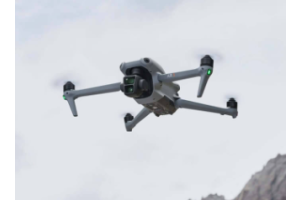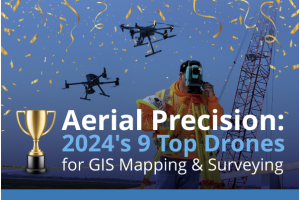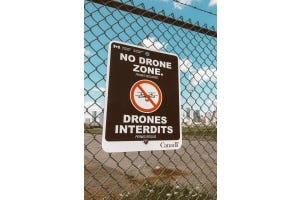Every drone pilot has a responsibility to the public when manoeuvring their UAVs through the airspace. Neglecting this responsibility can lead to dire consequences. There is a thin line between a thrill and a disaster, and its often blurred. Accidents have cost more than just money—they've risked lives. Let's look at some of the recent incidents and their impact, from drones almost crashing into helicopters and causing heart-stopping near-misses, to disrupting major events and critical operations. And, as the pilots discovered, the long arm of the law was not far behind.
5 Drone Pilot Blunders and Their Price
1. The Milanovic Saga: Close Encounters of the Dangerous Kind
Alexander Milanovic, a resident of Laguna Beach, California, was involved in multiple dangerous drone incidents between June 2022 and March 2023. His reckless operations led to serious safety concerns and legal consequences.
In the first incident on June 19, 2022, Milanovic flew his drone perilously close to an open-cockpit gyrocopter operated by a father and son near Crescent Bay Beach in Laguna Beach. His drone approached within 10 to 20 feet of the gyrocopter, forcing the son, who was piloting, to make an emergency maneuver to avoid a potential crash into the Pacific Ocean.


The second incident took place in July 2022, when Milanovic directed his drone towards a Discovery Channel “Shark Week” blimp flying over the Pacific near Laguna Beach. He flew the drone at an altitude of 500 to 1,000 feet, close enough to the blimp to compel its pilot to execute an emergency crash landing, posing a life-threatening risk.
The most alarming incident occurred in March 2023. Milanovic flew his drone dangerously close to a U.S. Coast Guard helicopter conducting operations off the coast near Laguna Beach. It came within 200 feet of the Jayhawk rescue helicopter, which had a four-member flight crew on board. The pilots had to take evasive action to avoid a potential collision with the drone, which could have resulted in a crash.
These incidents were brought to the attention of law enforcement in November 2022 after videos surfaced on TikTok showing Milanovic's drone flying dangerously close to aircraft. The investigation involved multiple agencies, including the Joint Terrorism Task Force, the Federal Aviation Administration (FAA), the Coast Guard, and the Orange County Sheriff's Department.
Milanovic pleaded guilty to three counts of unsafely operating an unmanned aircraft and faced a sentencing hearing under United States District Judge Fred W. Slaughter. He was sentenced to one year of probation and ordered to pay a $7,500 fine and perform 120 hours of community service. The case underscores the importance of adhering to safety regulations and the potential legal consequences of irresponsible drone usage
2. Airspace Anarchy: Ottawa's Rogue Pilot
In December 2022, a Canadian drone pilot faced significant fines for operating a drone in restricted airspace near Ottawa International Airport. This incident, detected by the airport's advanced Drone Detection Pilot Project, involved two unauthorized flights that posed a risk to airport safety.
The first flight, occurring on the morning of December 20, was particularly alarming. The drone pilot, operating a DJI Air 2S, began the flight in the parking lot of the World Fuel Services building. The drone initially hovered at ground level before ascending to a concerning altitude of 873 feet, which is significantly above Transport Canada's altitude limit of 500 feet for drone operation in authorized areas. This flight coincided with the arrival of a helicopter at the airport, intensifying the risk.
The second flight, originating from the parking lot of the Fairfield Inn & Suites by Marriott Ottawa Airport, saw the drone climb to 507 feet Above Ground Level. This flight happened concurrently with the landing of a Jazz Q-400 aircraft on Runway 25. Both flights occurred without the required notification to or approval by NAV Canada, and the drone was operated within a dangerously close range of 350 meters from an active runway.
The pilot, found operating the drone from his car, was surprised when approached by law enforcement and claimed ignorance of the regulations regarding flying near airports. However, ignorance of these regulations doesn't excuse the violations. Transport Canada, responsible for enforcing drone regulations, fined the pilot a total of $3,021 CAD. This included fines for multiple violations such as reckless operation, unregistered drone operation, flying in controlled airspace, and exceeding permitted altitudes.
3. Misadventure & Fines: Cesare's Costly Festival Flight
In an incident involving Daniel Cesare, a 36-year-old man from Derby, he was fined nearly £1,500 for multiple violations related to unauthorized drone flying. Cesare operated a DJI Mavic drone in the prohibited airspace above East Midlands Airport while trying to capture footage of the Download Festival, held at Donington Park in Castle Donington, Leicestershire. The drone was flown from a location about two miles from Donington Park, specifically from a recreation center in Shardlow, on June 9 and 10. The captured footage included day and night-time scenes of the festival, and notably, an airplane was seen landing in one of the shots.
Cesare pled guilty to seven offenses including flying an unmanned aircraft in a flight restriction zone without permission, failing to comply with maximum height restrictions, and failing to maintain visual line of sight with the drone. These violations occurred on June 9 and 10, coinciding with the festival dates. At the Southern Derbyshire Magistrates Court in Derby, Cesare was fined £1,008 for flying in the flight restriction zone and was additionally ordered to pay a £403 victim surcharge and £85 in costs, bringing the total penalty to £1,496. The court's decision highlighted the serious nature of these violations, emphasizing the safety risks posed by such unauthorized drone activities near an airport and a large public event like the Download Festival.
4. Forest Fire Folly: A Jarring Interference in Jasper
In September 2022, Rajwinder Singh faced a significant penalty for illegally operating his drone near an active wildfire in Jasper National Park, Alberta. This incident resulted in the largest fine ever issued for illegal drone operation in a Canadian national park, amounting to $10,000 CAD. Singh was discovered flying his drone in a restricted area during the Chetamon Mountain wildfire. This action caused a major disruption in the firefighting efforts, as the presence of the drone in the airspace necessitated the grounding of firefighting helicopters for over an hour. This not only impeded the efforts to control the wildfire but also potentially put the safety of the firefighters at risk.
Under Canadian law, particularly the Canada National Parks Act, operating a drone without a permit within a national park is prohibited and can result in substantial fines. Additionally, Canadian aviation regulations forbid aircraft, including drones, from flying within approximately a 9-kilometer radius of a forest fire without authorization. These rules are crucial to ensure the safety of both aircraft engaged in firefighting operations and the personnel involved. In this case, Singh's drone and its memory cards were confiscated, and he was given a deadline of June 8, 2023, to pay the fine. The incident underscores the serious consequences of unauthorized drone operations, especially in emergency situations like wildfires.
Also Read: Compilation Of The Best 15 Night Vision Drones
Notable Mentions
Before giving you #5, here are some incidents that deserve a mention. While no particular fines were involved, they show you how things can easily get out of hand when there are mistakes during drone usage:
Downfall Over the Yarra: A Malfunction in Melbourne
In Melbourne, Australia, a drone light show supporting the Matildas ahead of the Football World Cup encountered a significant technical malfunction.
During the display, a large number of drones, operated by the Australian Traffic Network (ATN), unexpectedly entered "automatic land" mode and fell into the Yarra River. The precise number of malfunctioning drones is reported to be around 350 out of 500 involved in the show. This unforeseen event led to the cancellation of a similar drone show planned in Brisbane, intended to celebrate nine years until the city hosts the Olympics and Paralympics, due to safety concerns.
The incident raised environmental worries, particularly regarding the potential impact of the drone batteries on the river. To address these concerns, a team of professional divers was deployed to recover the UAVs from the river, a task complicated by limited visibility underwater. Despite this setback, ATN emphasized that safety had been a priority throughout the incident, noting that no injuries occurred. The Australian Traffic Network also stated that this was the first technical issue they had faced in their 18 months of operation. The incident highlighted the need for thorough risk management plans, especially for popular drone shows conducted over water, to prevent such occurrences and mitigate their impact. The Australian Transport Safety Bureau (ATSB) has been involved in investigating the incident, calling for public footage to aid in their analysis.
Drone Problem at Fort Worth's Military Base
The Naval Air Station Joint Reserve Base in Fort Worth, Texas, has been facing a significant challenge with unauthorized drone activity in its airspace. Over recent years, there has been a drastic increase in the number of drone sightings, escalating from about 100 per month to around 300, and in some instances, this number has surged to as high as 700 sightings within a month. This alarming rise in drone incursions has posed a serious risk to military operations, particularly to fighter jet pilots who, on a couple of occasions, were forced to execute evasive maneuvers to prevent potential collisions with these drones.
Captain Mark McLean, the commanding officer of the base, attributes most of these drone violations to inexperienced and primarily younger drone operators, who may not fully comprehend the restrictions or the dangers associated with flying drones in such sensitive areas. While there appears to be no hostile intent behind these drone flights, the risk they pose is significant. A collision with a drone could have catastrophic consequences, endangering not only the pilots but also civilians in the vicinity. In response, the base and local authorities have intensified efforts to educate the public about the regulations and the designated restricted airspaces. Air traffic controllers and pilots at the base are now working more closely to monitor drone activities and avoid UAVs. Additionally, collaboration with federal law enforcement, including NCIS, and local police has been stepped up to locate and deal with the errant drone operators
The FAA's Remote ID rule, a significant policy in drone aviation, mandates the broadcasting of identification and location data for drones operating in U.S. airspace. This rule aims to enhance the safety and accountability of drone operations by providing a "digital license plate" for each drone. The rule applies to nearly all drones, but excludes lightweight drones used solely for recreation and those operated in FAA-Recognized Identification Areas (FRIAs). Compliance with this rule by deadline of March 16, 2024 is crucial for all pilots, as it integrates drones more safely into the National Airspace System and allows for efficient monitoring by authorities. Plus you don't want to find yourself facing more drone fines.
5. Brooklyn Duo's Mishap And Louisiana Security Breach
And finally, in Louisiana, two men from Brooklyn, New York, faced serious legal repercussions for flying a drone over critical infrastructure facilities. On February 21, the St. Charles Parish Sheriff's Office responded to a report of a drone flying over the Dow Chemical facility in Taft, Louisiana. The men, Volodymyr Dorogobid, 38, and Tigran Avetisyan, 39, were subsequently found near the scene in a black SUV. Dorogobid was operating the drone with a remote, while Avetisyan assisted using virtual reality goggles.
The investigation revealed that their drone had flown over three chemical companies: Dow, Linde, and American Air Liquide. Dorogobid and Avetisyan faced charges including three counts of unlawful use of an unmanned aircraft system and an additional felony count of evidence tampering. This felony charge stemmed from their attempt to conceal the drone in a field after being instructed to land it by the authorities. Their equipment, including the drone, cell phones, and goggles, was confiscated. The St. Charles Parish Sheriff's Office collaborated with the FBI to further investigate the case, highlighting the seriousness of the situation and the heightened concerns over the security of critical infrastructure facilities.
Fly Safe
Such incidents highlight not just the financial costs, but also the potential for serious harm and legal repercussions that can arise from careless or uninformed drone usage. To mitigate these risks, pilots can sign up for professional drone training programs that cover safe flying practices, legal regulations, and technical know-how for operating their UAVs. Taking time in training can substantially reduce the likelihood of accidents and incidents, thereby enhancing the overall safety and enjoyment of drone flying.
If you need any help with your drone or have questions, feel free to reach out to support@Dronefly.com or call 1(805) 480-4033 for assistance. Let's all fly safely and responsibly, keeping our skies accident-free.







